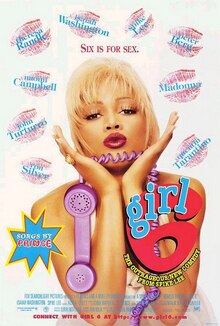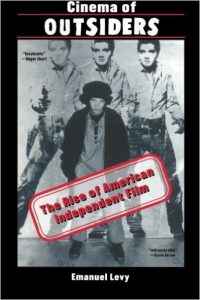Slight and not too deep, Spike Lee’s black comedy, Girl 6, arguably his weakest film to date, centers on one woman’s involvement in phone sex.
The film stars Theresa Randle, Isaiah Washington, and Lee.
Suzan-Lori Parks wrote the screenplay, making it the first film directed by Lee, which he did not write.
Girl 6 screened in the Un Certain Regard section of the 1996 Cannes Film Fest.
Quentin Tarantino and Ron Silver make cameo appearances as film directors at a pair of auditions.
Grade: C (*1/2* out of *****)
| Girl 6 | |
|---|---|

Theatrical release poster
|
|
The soundtrack is composed entirely of songs written by Prince.
The film’s best element is Theresa Randle’s performance, which overcomes the feature’s conceptual limitations by delivering a vulnerable and sensitive performance in a tough role that’s vastly underwritten.
Though written by a woman, Suzan-Lori Parks, Girl 6 is a shallow feature that looks at its protagonist and line of work completely from the outside.
Nominally, this film is meant to be a satirical character study of an aspiring black actress named Judy, who is forced to work at as phone-sex service.
Quite disappointingly, Lee’s considerable skills as a director are of no help, since the film lacks heart and soul; it doesn’t have much brain, or narrative, either.
The saga begins with Judy auditioning a monologue from Spike Lee’s impressive 1986 feature directorial debut She Gotta Have It, his only other film with a female at its center.
The nasty, distanced director Q.T. (played by cool auteur Quentin Tarantino) insists that she take off her shirt. Feeling unease and disgusted by his sleazy request, Judy walks out, thus losing her acting coach and agent.
What’s a girl to do?
Judy comes across newspaper ads for Ina’s Friendly Phone Line. Turns out she has some qualities for the position: Sexy, soothing voice and diverse skills at role-playing that makes her clients feel more desirable; sort of what Jane Fonda did in “Klute.” Moving up the ranks, Judy becomes one of the best employees of Lil (Jennifer Lewis), her mom-like boss.
Judy’s other encounters include a kleptomaniac former husband (Isiah Washington) and a sports-obsessed neighbor (Spike Lee). With such meager existence and social outlets, Judy throws herself into her phone-sex work.
In due course, fellow workers (played by indie actress Debi Mazar and model Naomi Campbell) warn Judy to quit her job, concerned that she might become too obsessive, even addictive, and delusional vis–vis the men she’s servicing on the phone. Predictable, the clients are erratic, demanding, and hostile to Judy.
Sequences with the customers, who are all types, are disappointing, though Lee believes they present a divertissement from Judy’s routine job. To variegate the proceedings, we get to see Judy’s acting fantasies, which include Dorothy Dandridge in Preminger’s honorable movie musical Carman Jones, or Pam Grier in the 1970s exploitation flick Foxy Brown (a fave of Tarantino as helmer), which are slightly more entertaining.
A story about a girl who has to fight for her life after falling down an elevator shaft seems to come out of nowhere, simply existing as an obvious metaphor for the heroine’s fall down.
Greeted with negative reviews, Girl 6 was a commercial flop, failing to recoup its considerable (for an indie) budget of $12 million.
For a much better depiction of women as sex-workers, please see Lizzie Borden’s Working Girls (1987).
Credits:
Directed, produced by Spike Lee
Written by Suzan-Lori Parks
Cinematography Malik Hassan Sayeed
Edited by Sam Pollard
Music by Prince
Production companies: Fox Searchlight Pictures, 40 Acres and a Mule Filmworks
Distributed by 20th Century Fox
Release date: March 22, 1996 (US)
Running time: 108 minutes
Budget $12 million
Box office $4.9 million











